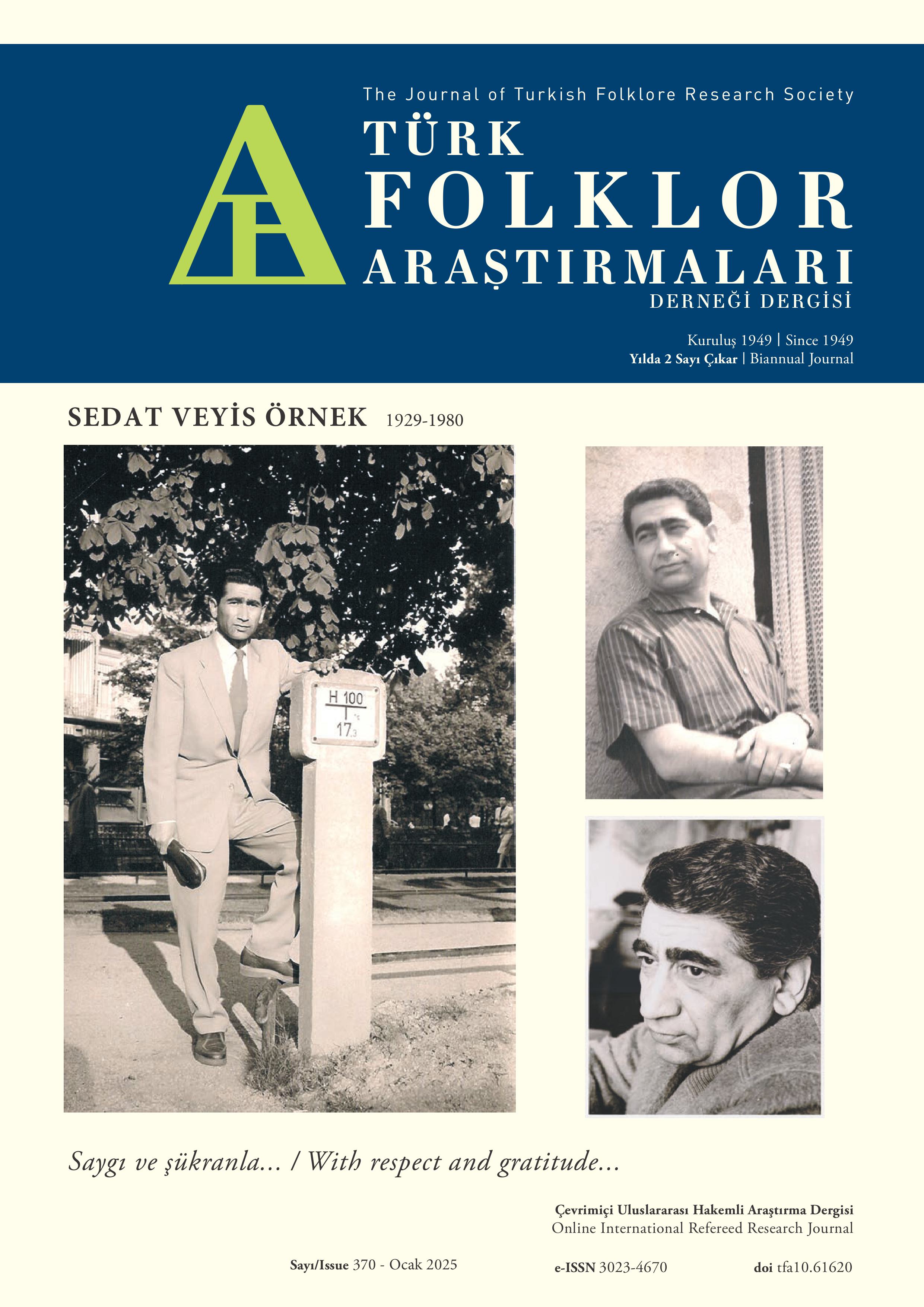Çömleğin Üretim, Yaşatılma ve Sürdürülme Serüveninde Gelenek Ustası Salim Yaşar
DOI:
https://doi.org/10.61620/tfa.40Anahtar Kelimeler:
el sanatları, çömlek, çömlekçilik, somut olmayan kültürel miras, yaşayan insan hazinesi Salim YaşarÖzet
Somut olmayan kültürel mirasın korunması kapsamında, obje odaklı kültürel mirasın yanı sıra bu objenin üretimi, korunması, bakımı ve yeniden yaratılması konusunda önemli rol oynayan “gelenek ustaları”na da odaklanılmıştır. Kültürel çeşitliliğin ve insan yaratıcılığının zenginliğinin ortaya konulması açısından, ustaların korunması ve sanatlarını sürdürmeleri gerektiği kabul edilmiştir. Bu bağlamda çömlek, ateşin kullanılarak yiyeceklerin pişirildiği, saklandığı, taşındığı; topraktan yapılmış kap olarak bir somut olmayan kültürel miras unsurudur. Kendine özgü yapısı, deseni, rengi ve üretim tekniği ile bilhassa göçebe hayattan yerleşik hayata geçilmesi sonucunda önem kazanan çömlek, usta ellerde bugün de üretilmekte, aktarılmakta ve yaşatılmaktadır. Bu makalede, Yaşayan İnsan Hazinesi (YİH) seçilen çömlek ustası Salim Yaşar ile yapılan yüz yüze görüşmeden elde edilen veriler ışığında, ustanın hayatı, sanatı, çalışmaları ve üretimi paralelinde çömlekçilik geleneğinin güncellenerek bugüne ulaşması ele alınmıştır. Tespit ve değerlendirmeler sonucunda, çömlek ustası Salim Yaşar’ın; çömlek yapımındaki geleneksel özü, yurt dışı tecrübesiyle birleştirerek; teknik, şekil, desen, motif ve renk bakımından çömleği günümüze taşıdığı görülmüştür. Teknolojinin gelişmesi ve yaşam koşullarının değişmesi nedeniyle çömleğe olan ihtiyaç ve ilginin azaltması karşısında usta, temsil ve sunum bakımından çömleği güncellemiştir. Yapmış olduğu güncellemeler ve canlandırmalarla çömleğin kullanım alanlarını genişletmiş, kültür endüstrisi açısından çömleği günlük hayatta kullanılır bir obje hâline getirmiştir.
Referanslar
Acartürk, B. (2012). Kültürümüzde toprak. Tematik Türkoloji Dergisi, Cilt: 4, Sayı: 1.
Başgelen, N. (2005). Van kalesinin kahraman kralları Urartular. Seramik Türkiye, Seramik Federasyonu Dergisi, Sayı: 6, s. 128-135.
Bayazit, M. (2004). Kınık (Pazaryeri-Bilecik) çömleklerinin termal şok dirençlerinin sedimenter sepiyolit katkısı ile iyileştirilmesi. Yüksek Lisans Tezi. Kütahya: Dumlupınar Üniversitesi, Fen Bilimleri Enstitüsü.
Cooper, E. (1978). Seramik ve çömlekçilik. İstanbul: Remzi Kitabevi.
Çoşkun, Seçil vd. (haz.) (2013). Gelenekten geleceğe: Türkiye'de somut olmayan kültürel miras. Ankara: T.C. Kültür Bakanlığı Yayınları.
Danner, V. (1995). Din ve gelenek, kutsalın peşinde, Ed. S. H. Nasr, K. O’brien. Çev. S. E. Gündüz. İstanbul: İnsan Yayınları, s. 25-36.
Ekici, M. (2008). Geleneksel kültürü güncellemek üzerine bir değerlendirme. Millî Folklor, Cilt: 80, s. 33-38
Eroğlu, E. ve Köktan, Y. (2013). Geleneksel Türk el sanatlarından çömlekçilik (Sakarya Örneği). Akademik Bakış Dergisi, Sayı: 36, s. 1-14.
Güner, G. (1988). Anadolu’da yaşamakta olan ilkel çömlekçilik. İstanbul: Ak Yayın.
Hauptmann, H. ve Özdoğan M. (2007). Anadolu’da neolitik devrim. Lichter Clemens (Ed), İnsanlığın en eski anıtları: 12.000 yıl önce Anadolu, İstanbul.
Kasapoğlu Akyol, P. (2013) Türkiye’nin yaşayan insan hazineleri programı. Somut olmayan kültürel mirasın geleceği Türkiye deneyimi. Ed. Ö. Oğuz, E. Ölçer Özünel, S. Gürçayır Teke. Ankara: UNESCO Türkiye Milli Komisyonu, Grafiker Yay. s. 83-89.
Koçak, R. (2015). Aydın-Karacasu çömlekçiliği ve ustaları üzerine bir araştırma. Yüksek Lisans Tezi, Ankara: Gazi Üniversitesi.
Matson, F. (1995). Potters and pottery in the ancient near east. Civilizations of the ancient near east. Ed. J., M., Sasson, Cilt: 3, Sayı: 3, s. 1553.
Meke, Saadet (2019). Kınık (Bilecik-Pazaryeri) Çömlekçiliğinin geçmişten günümüze teknik ve teknolojik açıdan gelişim süreci. Yüksek Lisans Tezi, İzmir: Dokuz Eylül Üniversitesi.
Somut olmayan kültürel mirasın korunması sözleşmesi. Çev. Ö. Oğuz, Y. Özay, P. Tacar. Millî Folklor, Cilt: 65, s. 163-171.
Oğuz, M. Ö. (2007) Folklor ve kültürel mekân. Millî Folklor Cilt: 76, s. 30-32.
Oğuz, M. Ö. (2008). UNESCO ve geleneğin ustaları. Milli Folklor, Cilt: 77, s. 5-10.
Oğuz, M. Öcal (2013). Terim olarak kültürel miras nedir? Milli Folklor Dergisi, Cilt: 25, Sayı: 100, s. 5-13.
Oğuz, M. Ö. (2018). Somut olmayan kültürel miras nedir? Ankara: Geleneksel Yayıncılık.
Ölçer Özünel, E. (2011). Kültür turizminde ‘yöresel’ ve ‘otantik’ olanı sorgulamak ve tüketilmiş mekânları yeniden üretmek üzerine. Turkish Studies. Cilt: 6, Sayı: 4, s. 255-262.
Özbaşaran M., Aşıklı. (2012). The neolithic in Turkey new excavation & New Research Central Turkey. Edited by: M. Özdoğan, N. Başgelen, P. Kuniholm, İstanbul: Archaeology & Art Publications. s. 135-158.
Özdoğan, M. (2007). Neolitik dönem: Günümüz uygarlığının temel taşları, 12000 yıl önce uygarlığın Anadolu’dan Avrupa’ya yolculuğun başlangıcı neolitik dönem. İstanbul: Yapı Kredi Yayınları.
Özkul Fındık, N. ve Beder, S. (2021). Çömlekçilik, Geleneksel meslekler ansiklopedisi. Ed.: Soysaldı, A., Ankara: Ticaret Bakanlığı Yayınları. s. 251-260
Sagona, A. ve Zimansky, P. (2009). Arkeolojik veriler ışığında Türkiye’nin en eski kültürleri MÖ 1.000.000-550. İstanbul: Arkeoloji ve Sanat Yayınları.
Türedi, Ö. A. (1999). Ateşin toprağa hükmettiği sanat. İstanbul: Süreli Sanat ve Kültür.
Tönnies, F. (2022). Gelenek. İstanbul: Pınar Yayınları.
Ünal, T. vd., (2020). Bilecik ilinin gelişiminde etkili olan ekonomik unsurlar, dördüncü ünite, şehrimiz Bilecik. Komisyon. Milli Eğitim Bakanlığı Yayınları. s. 68-77.
Yalçın, G. ve Özfırat, A. (2006). Anadolu ve Önasya’da çanak çömleğin gelişimi. Uluburun Gemisi 3000 Yıl Önce Dünya Ticareti. Ed. Ü. Yalçın, C. Pulak, R. Slotta, Bodrum.
URL-1: https://yakegm.ktb.gov.tr/TR-12929/yasayan-insan-hazineleri-ulusal-envanteri.html (07.08.2024)
İndir
Yayınlanmış
Nasıl Atıf Yapılır
Sayı
Bölüm
Lisans
Telif Hakkı (c) 2025 Aslı Büyükokutan Töret

Bu çalışma Creative Commons Attribution 4.0 International License ile lisanslanmıştır.



